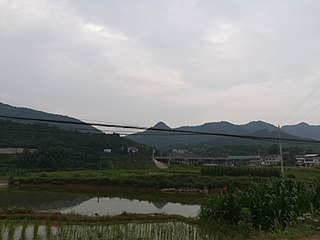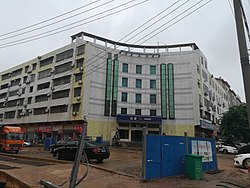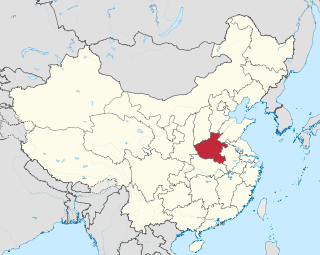Changqing may refer to the following locations in China:

Dongxihu District is one of 13 districts of Wuhan, the capital of Hubei province, People's Republic of China, forming part of the city's western suburbs. It lies on the north (left) bank of the Han River. Along with Qiaokou, it is the only district of Wuhan to not have a Yangtze River shoreline; it borders the districts of Huangpi to the northeast, Jiang'an to the east, Jianghan, Qiaokou, and Hanyang to the southeast, and Caidian to the southwest. The district also borders the prefecture-level city of Xiaogan to the north and west.

Louxing District is the only urban district and the seat of Loudi Prefecturel-level City, Hunan Province, China.

Tiedong District is a district of the city of Anshan, Liaoning province, People's Republic of China. It is the seat of Anshan's government and the main business and shopping district of the city.

Qingshanqiao is a town in Ningxiang City, Hunan Province, China. It borders Loudi in the west, Lianyuan in the northwest, Longtian Town and Shatian Township in the north, Liushahe Town in the east, and Xiangxiang in the south. As of the 2010 census it had a population of 52,000 and an area of 138 square kilometres (53 sq mi). It is located at the intersection of Highway S209 and Highway S311, on the banks of the Chu River.

Laoliangcang Town is a rural town in Ningxiang City, Hunan Province, China. It is surrounded by Huangcai Town on the northwest, Hengshi Town on the northeast, Shuangfupu Town on the east, Fengmuqiao Township on the southeast, and Liushahe Town on the southwest. As of the 2007 census it had a population of 63,000 and an area of 121.8 square kilometres (47.0 sq mi). It is famous for the bronze culture of the Shang culture.

Liushahe Town is a rural town in Ningxiang City, Hunan Province, China. It is surrounded by Qingshanqiao Town on the west, Huangcai Town and Shatian Township on the north, Laoliangcang Town and Fengmuqiao Township on the east, and Fanjiang Town on the south. As of the 2007 census it had a population of 68,780 and an area of 140.57 square kilometres (54.27 sq mi).

Yutan Subdistrict is a subdistrict in Ningxiang City, Hunan Province, China. It borders Baimaqiao Subdistrict to the southwest, Chengjiao Subdistrict to the north and Lijingpu Subdistrict to the southeast. As of 2010, it has a population of 200,000 and an area of 20 square kilometres (7.7 sq mi).

Jili Subdistrict is an urban subdistrict in Liuyang City, Hunan Province, People's Republic of China. As of the 2015 census it had a population of 58,370 and an area of 153.8-square-kilometre (59.4 sq mi). Taipingqiao Town merged to Jili Subdistrict on November 18, 2015. It borders Jiaoxi Township in the north, Guankou Subdistrict in the northeast, Huaichuan Subdistrict in the southeast, Gejia Township in the west, Dongyang Town in the northwest, and Hehua Subdistrict and Chengchong Town in the south.

Xikuangshan Subdistrict is an urban subdistrict in Lengshuijiang, Loudi City, Hunan Province, People's Republic of China. As of the 2015 census it had a population of 30,500 and an area of 67.05-square-kilometre (25.89 sq mi).

Shuidongdi is a rural town in Louxing District of Loudi, Hunan, China. It has an area of 89 km2 (34 sq mi) with a population of 40,943. The town has 24 villages and a community under its jurisdiction. The town was transferred from Lianyuan City to Louxing on January 24, 2017.

Dabuqiao Subdistrict is a subdistrict in Louxing District of Loudi City, Hunan Province, People's Republic of China.

Dake Subdistrict is a subdistrict in Louxing District of Loudi City, Hunan Province, People's Republic of China. The building of Loudi Municipal Government lies in the subdistrict.

Huangnitang Subdistrict is a subdistrict in Louxing District of Loudi City, Hunan Province, People's Republic of China.

Huashan Subdistrict is a subdistrict in Louxing District of Loudi City, Hunan Province, People's Republic of China.

Leping Subdistrict is a subdistrict in Louxing District of Loudi City, Hunan Province, People's Republic of China.

Lianbin Subdistrict is a subdistrict in Louxing District of Loudi City, Hunan Province, People's Republic of China. As of the 2015 census it had a population of 41,500 and an area of 28-square-kilometre (11 sq mi).

Shanshan Town is a rural town in Louxing District of Loudi City, Hunan Province, People's Republic of China. As of the 2015 census it had a population of 43,200 and an area of 66.38-square-kilometre (25.63 sq mi).

Shijing Town is a rural town in Louxing District of Loudi City, Hunan Province, People's Republic of China. As of the 2015 census it had a population of 37,900 and an area of 65-square-kilometre (25 sq mi).

Wanbao Town is a rural town in Louxing District of Loudi City, Hunan Province, People's Republic of China. As of the 2015 census it had a population of 4,4500 and an area of 81.05-square-kilometre (31.29 sq mi).



















